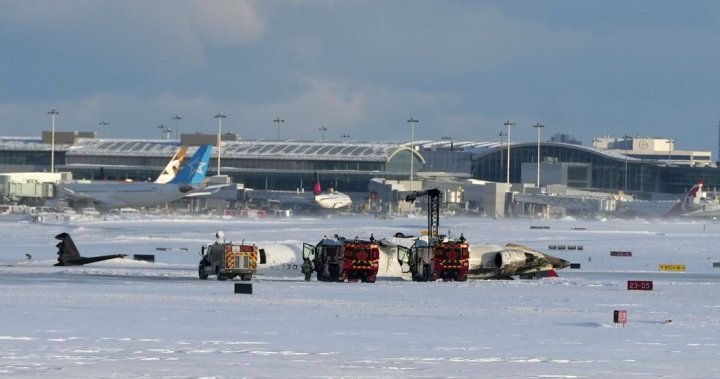Canada
Here’s the latest on the Delta plane crash at Toronto Pearson airport

A Harrowing Incident: Delta Flight 4819 Crash Lands at Toronto Pearson International Airport
On Monday afternoon, a gripping scene unfolded at Toronto Pearson International Airport when Delta Air Lines Flight 4819 crash-landed, flipping onto its roof. The incident sent shockwaves through travelers and aviation enthusiasts alike, though miraculously, no lives were lost. The flight, operated by Endeavor Air, was carrying 76 passengers and four crew members, including 22 Canadian nationals. As details continue to emerge, the aviation community is left grappling with questions about what caused this terrifying ordeal.
Crash Details: A Routine Flight Turns Tragic
Delta Flight 4819 departed from Minneapolis bound for Toronto, a journey that typically takes just over two hours. The aircraft, a Mitsubishi CRJ-900LR, was a modern regional jet known for its reliability. At around 2:30 p.m. ET, the plane touched down at Pearson Airport under challenging weather conditions. However, something went horribly wrong during landing. The aircraft flipped onto its roof, coming to rest upside down on the snowy tarmac. Despite the alarming images shared on social media, all 80 individuals on board were accounted for, and Emergency services responded swiftly.
Weather Conditions: A Perfect Storm of Challenges
The day of the crash saw harsh winter weather gripping Toronto, with blowing snow and gusty winds reaching up to 65 km/h. The temperature hovered around minus 8.6 degrees Celsius, creating treacherous conditions for pilots and airport operations. The deteriorating weather was part of a larger winter storm that had battered the region over the weekend, leaving a trail of disruption in its wake. While the exact cause of the crash remains unclear, aviation experts speculate that the combination of icy runways and powerful crosswinds could have played a role.
Airport Response: A Textbook Emergency Operation
In the wake of the crash, the response from airport emergency services was nothing short of heroic. Deborah Flint, President and CEO of Toronto Pearson International Airport, praised the emergency workers for their rapid and well-coordinated efforts. Within minutes of the incident, first responders were on the scene, evacuating passengers and tending to the injured. Firefighters were seen dousing the overturned aircraft as passengers emerged, some shaken but remarkably resilient. The airport’s preparedness and the professionalism of its staff undoubtedly prevented a potentially catastrophic situation from worsening.
Investigation: Piecing Together the Puzzle
As the investigation into the crash begins, officials are urging patience. The Transportation Safety Board of Canada (TSB) has taken the lead in determining the cause of the incident. Early observations suggest that the plane’s nose landing gear remained intact, while the two other wheels and landing gear were sheared off. One regional airline pilot, speaking anonymously, noted that the damage indicates the aircraft may have been moving laterally during landing rather than being aligned straight down the runway. He suggested that high winds, icy runways, or a combination of both could have led to the loss of control.
Impact on Travelers: Delays and Disruptions
The crash has left Toronto Pearson International Airport grappling with operational challenges. Two runways were closed to accommodate the investigation, leading to significant delays and disruptions. Passengers traveling through Pearson are advised to check their flight status regularly and stay in contact with their airlines. This latest incident compounds an already difficult period for travelers, following a wave of cancellations and delays caused by the weekend’s winter storm.
The crash of Delta Flight 4819 serves as a stark reminder of the complexities and risks inherent in air travel, even as it underscores the resilience of passengers and the professionalism of emergency responders. As the investigation unfolds, the focus will remain on identifying the root causes and ensuring that such an incident is never repeated. For now, the aviation community breathes a collective sigh of relief that no lives were lost, while travelers are urged to exercise patience and vigilance in the face of ongoing disruptions.











